The project explores possible conditions of cohabitation through the design of domestic prosthetics for the single-family detached house. Three subtle appendages—the Compost Chimney, the Extended Eave, and the Habitat Dormer— each re-imagine the design of conventional building components. The prosthetics augment the boundary between human and animal domains and invite animals to adapt to the suburban biome, inhabiting the periphery of the domestic realm. By engaging animals within human systems, the domestic prosthetics seek to shift the conceptual limits of human territory to enable animal cohabitation within the suburban biome.
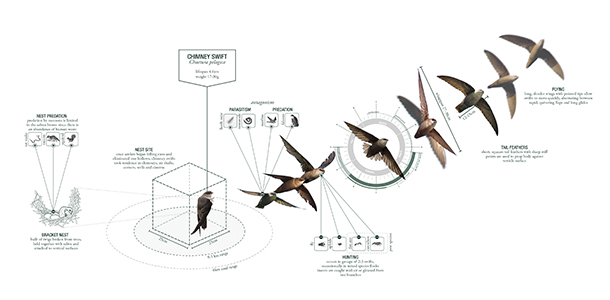
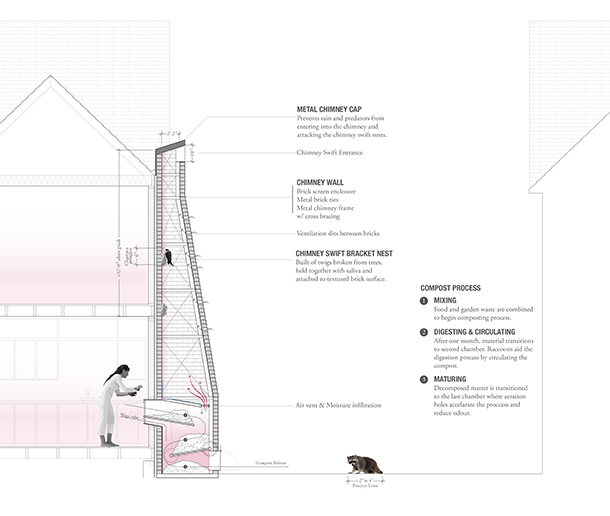
The Compost Chimney prosthetic engages a common and problematic species, the raccoon. This medium sized, nocturnal creature is notorious for using its ingenuity and dexterous paws to gain access into garbage bins from which it can feast upon a bounty of leftover food. In the city, the raccoon is an inevitable neighbour, instead of lamenting their abilities, the Compost Chimney prosthetic seeks to productively employ them in the conversion of organic waste to nutrient rich soil. Homeowners insert food waste from the kitchen into the composting chamber. An external gear wheel, which the raccoon can easily rotate, circulates a conveyor belt inside which aerates and moves the compost. In exchange for their labour, the raccoon receives a morsel of food dispensed from the Wage Tube.
Meanwhile the upper volume of the Compost Chimney provides much needed habitat for chimney swifts, a unique bird whose sporadic flight pattern and inability to perch differentiate it from other species. Historically, the cigar shaped birds have found refuge in masonry chimneys where they attach their twig nests to the interior walls using saliva. However, with the transition towards electric heating and eventually, gas fireplaces, the chimney is no longer a fixture of suburban houses. The subsequent lack of available cavities has led to a decline in population. Affixing a Compost Chimney prosthetic to any suburban home could provide chimney swifts with safe habitat while simultaneously managing food waste and fortifying the suburban soil. 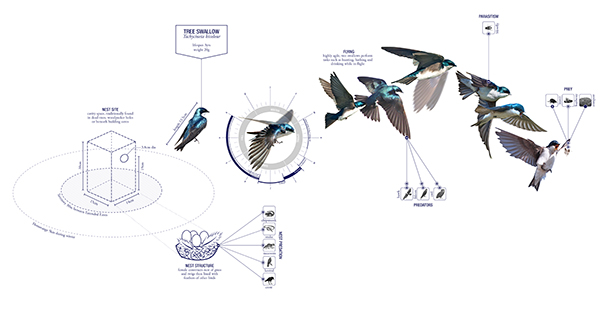


Bluebirds and tree swallows have suffered population decline due reduction in available nesting sites and heavy competition with two highly aggressive synanthropes, house sparrows and European starlings. The Extended Eave prosthetic seeks to support these vulnerable cavity dwelling birds by coupling appropriately dimensioned nesting sites for each species within an alternative roof gutter system. It merges water mitigation systems with exhaust vents to
The generous eaves trough improves the function and aesthetic value of the house by capturing runoff from the roof in a vegetated garden container, reducing the buildup of debris, then slowly releasing water down to the landscape below. Water-loving bluebirds and tree swallows can use the garden to bathe and drink in flight. An up-vent carries controlled and filtered heat, exhausted from the house, upwards to warm the nest cavities during the cool, shoulder seasons. For homeowners, the Extended Eave brings new life to the facade of their building.
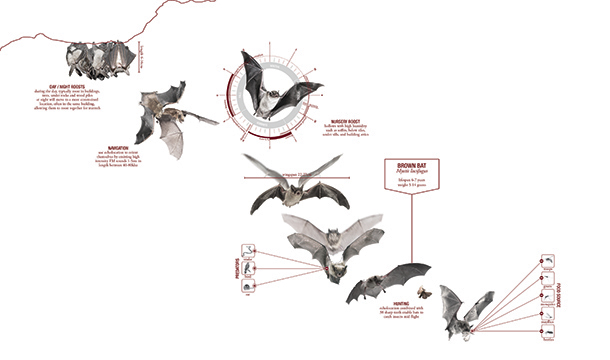

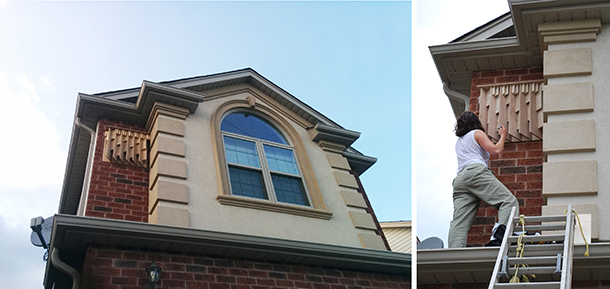
The Habitat Dormer prosthetic strives to integrate two pest control species, the barn owl and the more feared little brown bat. Historically, barn owls took shelter in the rafters of barns and in exchange, consumed and controlled abundant rodent populations in agricultural fields. With changes in agrarian practices, rodenticide replaced owls as the predominant form of pest control and as a result, barn owl populations have declined. Meanwhile, little brown bats, the most common bat species in Canada, are suffering similar declines due to white-nose syndrome, a disease found in damp caves. Previously, bats could also find shelter in drafty barns and attics or beneath cladding materials, however, as building enclosures become more sealed-off, they no longer provide as many habitat opportunities for animals. Despite negative cultural perception, bats make for beneficial neighbours as the bat’s diet is composed entirely of insects, predominantly mosquitos.
The Habitat Dormer accommodates these two nocturnal species in exchange for their pest control services. A cavity at the peak of the dormer provides security for a family of barn owls while the slatted, wood cladding of the prosthetic suites the roosting needs of the little brown bat. Beneath the animal activity, the homeowner enjoys both the added real estate provided by the dormer and the absence of pesky rodents and insects thanks to their new neighbors.
By appropriating the vernacular of suburban architecture, the prosthetics can infiltrate the suburbs, generating habitat opportunities in this novel ecosystem. The domestic prosthetics engage the targeted species in natural systems of resource production, pest control, and ecological condition, in order to re-position synanthropic animals and desirable and productive neighbors within the suburban environment. In turn, homeowners are conditioned to perceive synanthropes as allies instead of enemies. Overtime, control is relinquished to the dynamics of the local ecology and homeowners become stewards of their own domestic environment.
This is only a preview of the essay “Synanthropic Suburbia” in the forthcoming volume of LUNCH: Domestication, a design research journal edited by students at the University of Virginia School of Architecture. Find the full article and design project, as well as other interesting work, in their exciting upcoming publication!







